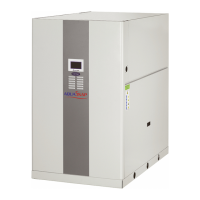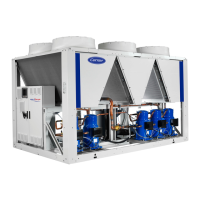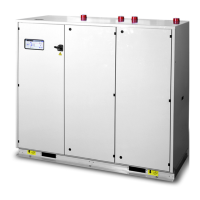65
20 - MAINTENANCE
During the unit operating life the service checks and tests must be carried out in accordance with applicable national regulations.
If there are no similar criteria in local regulations, the information on checks during operation in annex C of standard EN 378 can be
used.
External visual checks: annex A and B of standard EN378.
Corrosion checks: annex D of standard EN 378. These controls must be carried out:
- After an intervention that is likely to affect the resis-tance or a change in use or change of high-pressure refrigerant, or after a shut
down of more than two years. Components that do not comply, must be changed. Test pressures above the respective component
design pressure must not be applied (annex B and D).
- After repair or signicant modications or signicant system or component extension (annex B).
- After re-installation at another site (annexes A, B and D).
- After repair following a refrigerant leak (annex D). The frequency of refrigerant leak detection can vary from once per year for
systems with less than 1% leak rate per year to once a day for systems with a leak rate of 35% per year or more. The frequency
is in proportion with the leak rate.
NOTE: High leak rates are not acceptable. The necessary steps must be taken to eliminate any leak detected.
NOTE 2: Fixed refrigerant detectors are not leak detectors, as they cannot locate the leak.
20.1 - Soldering and welding
Component, piping and connection soldering and welding operations must be carried out using the correct procedures and by qualied
operators. Pressurised containers must not be subjected to shocks, nor to large temperature variations during maintenance and repair
operations.
Any technician attending the machine for any purpose must be fully qualied to work on refrigerant and electrical circuits.
WARNING: Before doing any work on the machine ensure that the power is switched off. If a refrigerant circuit is opened, it
must be evacuated, recharged and tested for leaks. Before any operation on a refrigerant circuit, it is necessary to remove
the complete refrigerant charge from the unit with a refrigerant charge recovery unit.
All removal and refrigerant draining operations must be carried out by a qualied technician and with the correct material for the unit.
Any inappropriate handling can lead to uncontrolled uid or pressure leaks.
If an oil draining or recovery operation becomes necessary, the uid transfer must be made using mobile containers.
20.2 - General system maintenance
Keep the unit itself and the space around it clean and free of obstructions. Remove all rubbish such as packing materials, as soon as
the installation is completed.
Regularly clean the exposed pipework to remove all dust and dirt. This makes detection of water leaks easier, and they can be repaired
before more serious faults develop.
Conrm that all screwed and bolted connections and joints are secure.
Secure connections prevent leaks and vibration from developing.
Check that all foam insulation joints on the heat exchanger piping are in good condition.
Regularly check that the vibration levels remain acceptable and close to those at the start of using the unit.
For units equipped with pump, regulary check that no leak appears on the pump. High concentration of glycol leads to faster degradation
of pump mecanical seal.

